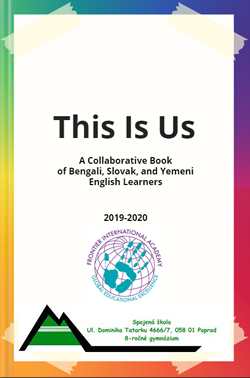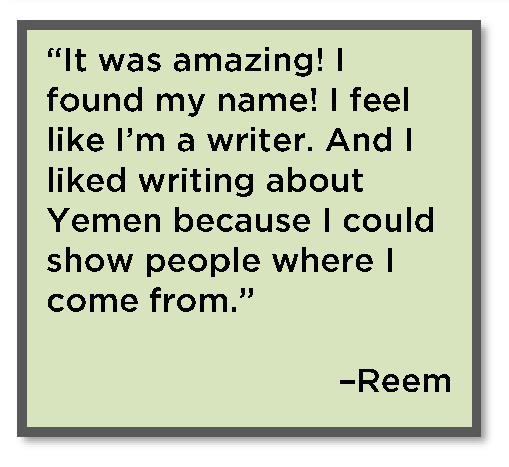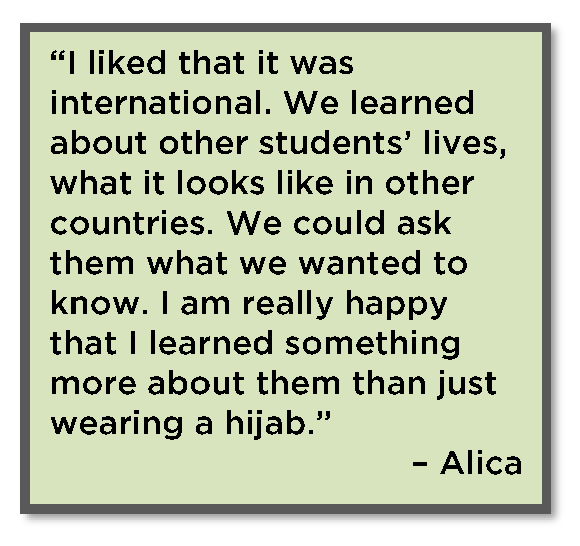Virtual Exchange: Collaborating to Create
by Margita Vojtkulakova

Online language teaching has challenged English
language educators to be creative and flexible in what many have found to be a
difficult learning environment. Though inferior in many ways, in others, online
learning brought about several benefits. The most evident one is the
flexibility inherent in online communication—communication at any time and from
almost anywhere.
 Drawing
upon this benefit, I organized a virtual exchange (VE; see O’Dowd, 2021; Tomaš
et al., 2021) that brought together two groups of students: English as a second
language learners from Michigan and English as a foreign language learners from
Slovakia.
Drawing
upon this benefit, I organized a virtual exchange (VE; see O’Dowd, 2021; Tomaš
et al., 2021) that brought together two groups of students: English as a second
language learners from Michigan and English as a foreign language learners from
Slovakia.
Together,
these two groups of students developed an e-book project that we called “This
Is Us” (click here
to see the book). According to Lewis & O’Dowd (2016), there are three
main types of VEs (also known as online intercultural exchanges):
-
information exchange
tasks
-
comparison and analysis
tasks
-
collaborative tasks
For my e-book project, we
incorporated both information exchange and collaborative tasks that included
writing about ELs’ cultures and countries of origin, writing about their
experience living in different countries, and creating the actual e-book. The
following approaches guided the project:
-
Promoting an asset-based view
of English learners (ELs) as multilingual and multicultural citizens. The
entire project built on an approach through which learners were positioned to
be assets to the created collaborating community.
-
Creating meaningful opportunities to produce multimodal
writing, practice descriptive and informative writing, offer peer feedback, and
improve editing skills.
Steps to Develop a Virtual Exchange E-Book Project
1. Find an
International Collaborator
To initiate
a VE project, you’ll need an international partner. In my case, I reached out
to an English as a foreign language teacher in Slovakia I knew from my college
studies who works with learners of the same age as my students.
Here are
some places where you could find collaborating parties:
-
Visit iEARN.org -
Global Project Collaboration website. To connect with the iEARN community,
click here.
Some ideas for VE can be found on their iEARN Project Space page.
-
Visit different platforms
that provide opportunities for networking. Some of those platforms
are:
Reach out to
someone you think would make a good partner and explain the project, including
your preliminary timeline and your goals for your students, to see if they are
interested and able to work with you.
2. Collaborate to
Develop the Exchange
After
finding a collaborator, it’s helpful to discuss the interests of the
collaborating students, language proficiency, their assets, and the possibility
of synchronous meetings. In addition, I recommend discussing what kind of
platform you would be using for your VE and how often you would update each
other on the project.
It’s also
advantageous to have some concrete ideas for projects that may be engaging and
feasible, and to discuss pros and cons of different approaches with your partner(s).
You can discuss which of the three main types of VEs may be the best fit for
your students and goals, and then brainstorm some potential VE projects.
Once you
have a few solid ideas, you can introduce them to the students and let them
choose, or ideally, a project idea comes from the students after mutual
introductions. The introduction can be done via a short video or a written bio
of the class or of each student (using, e.g., Google Docs, Google Slides, Jamboard,
or Padlet).
3. Create an Invested
Online Community
Regardless
of what type of task you choose, be sure to spend some time initially on
creating a positive and respectful collaborative community. First, our students
got to know each other asynchronously by introducing themselves on Padlet.
Then, we had synchronous meetings—in the beginning all together, and after a
couple of meetings in breakout rooms. After a few meetings, students felt
comfortable working in small international teams on a set of challenges
prepared by the teachers. Challenges should offer space for all the team
members to contribute (see Challenge 1; Appendix A) and have students build on
their assets rather than on their language skills (see Challenge 2; Appendix
B).
4. Guide Students to
Create an E-Book
 After
brainstorming about what they would like to know about each other, students
dove into informative, descriptive, or personal writing based on the questions
posed from the collaborating party. They were writing about something that they
considered “theirs,” and they had their own background knowledge as an asset to
achieve it. In addition, students had in mind that there was an authentic
audience—someone who was truly interested in their writing.
After
brainstorming about what they would like to know about each other, students
dove into informative, descriptive, or personal writing based on the questions
posed from the collaborating party. They were writing about something that they
considered “theirs,” and they had their own background knowledge as an asset to
achieve it. In addition, students had in mind that there was an authentic
audience—someone who was truly interested in their writing.
Once they
finished the first drafts, students provided feedback to and received feedback
from their international peers. At this stage, learners served as assets to
each other. As language learners from various learning environments, they had
different experiences with English language acquisition. For example, on one
hand, whereas Slovak ELs tend to excel in English grammar and spelling because
these are often viewed as instructional priorities in that context, they often
lack fluency and struggle to use common collocations. On the other hand,
Michigan ELs are exposed to English every day and are generally more fluent,
but many lack experience in structuring paragraphs, using grammar structures
correctly, or spelling accurately.
 Using
prompts provided in Google Docs, students provided a compliment (“What do you
like about this writing?”) and then a suggestion (“How can the writer make this
writing better?”) to their international peers. After addressing the feedback,
the process of creating an e-book began. This included students making
decisions about pictures, format, and design while developing their creative
and collaborative skills. Instead of pointing out mistakes, the focus was on
giving students a voice and a feeling of authorship. Students enjoyed
practicing these digital skills that contributed to their skillset of global
learners.
Using
prompts provided in Google Docs, students provided a compliment (“What do you
like about this writing?”) and then a suggestion (“How can the writer make this
writing better?”) to their international peers. After addressing the feedback,
the process of creating an e-book began. This included students making
decisions about pictures, format, and design while developing their creative
and collaborative skills. Instead of pointing out mistakes, the focus was on
giving students a voice and a feeling of authorship. Students enjoyed
practicing these digital skills that contributed to their skillset of global
learners.
Online Tools for Creating an
E-Book
For our
e-book, we used Book
Creator, which offers a free account for individual users and
provides a link, which can easily be shared, for collaboration. Following are a
few other resources that can be drawn upon in creating e-books:
-
Google
Slides: A template by SlidesMania can be found here.
If learners do not have regular access to the internet, the slides can be
printed and used as book pages, and then scanned and shared via Google Drive by
the project facilitators. Another option is to exchange hard copies of the book.
-
Canva:
Canva offers numerous templates for posters, newsletters, infographics,
invitations, magazines, and so on.
-
Newlywords:
Newlywords is a resource similar to Book Creator. For free, users can
collaborate on an e-book and can download their final product in a pdf
format.
Concluding Thoughts
Once our
e-book was finished, students took pride in sharing the final product with
their peers, friends, and family. The e-book project was followed up by
reflection and continuous international synchronous meetings.
 This
international project approached all students through an asset-oriented lens
and capitalized on the advantages of virtual learning. Students were engaged in
interactive tasks, inter- and intra-cultural discussions, and developing a set
of 21st-century skills (global citizenship, creativity, communication). Through
this unique virtual collaborative experience, we increased student engagement
and positive identity while challenging ourselves as teachers to grow into
global educators.
This
international project approached all students through an asset-oriented lens
and capitalized on the advantages of virtual learning. Students were engaged in
interactive tasks, inter- and intra-cultural discussions, and developing a set
of 21st-century skills (global citizenship, creativity, communication). Through
this unique virtual collaborative experience, we increased student engagement
and positive identity while challenging ourselves as teachers to grow into
global educators.
Acknowledgements
I would like
to express my great thanks to the collaborating Slovak educators Ms. Patrícia
Folvarčíková and Ms. Daniela Škurlová from Spojená škola Dominika Tatarku
Poprad. My thanks goes to Dr. Najim Ahmed, my colleague at Frontier
International Academy in Detroit, who helped facilitate the project. I also
want to thank Dr. Zuzana Tomaš for being my mentor in this project and always
inspiring me to do more and better as a teacher.
References
Lewis, T.,
& O’Dowd, R. (2016). Introduction to online intercultural exchange and
this volume. In R. O’Dowd & T. Lewis (Eds.), Online
intercultural exchange: Policy, pedagogy, practice (pp. 3–20).
Routledge.
O’Dowd, R. (2021).
Virtual exchange: Moving forward into the next decade. Computer
Assisted Language Learning. https://doi.org/10.1080/09588221.2021.1902201
Tomaš, Z., Vojtkulakova, M., Lehotska,
N., & Schottin, M. (2021). Examining the value of online intercultural
exchange (OIE) in cultivating agency-focused, (inter)culturally and
linguistically responsive pedagogy: A story of one collaborative international
project for English learners. Language Arts Journal of Michigan,
36(1), 51–64. https://doi.org/10.9707/2168-149X.2267
Margita Vojtkulakova has TESOL graduate credentials from Matej Bel University in Slovakia and Eastern Michigan University in the United States. She is currently working as an ESL teacher at Frontier International Academy in Detroit, Michigan, USA. She is a published author and a frequent presenter at MITESOL and TESOL conferences.